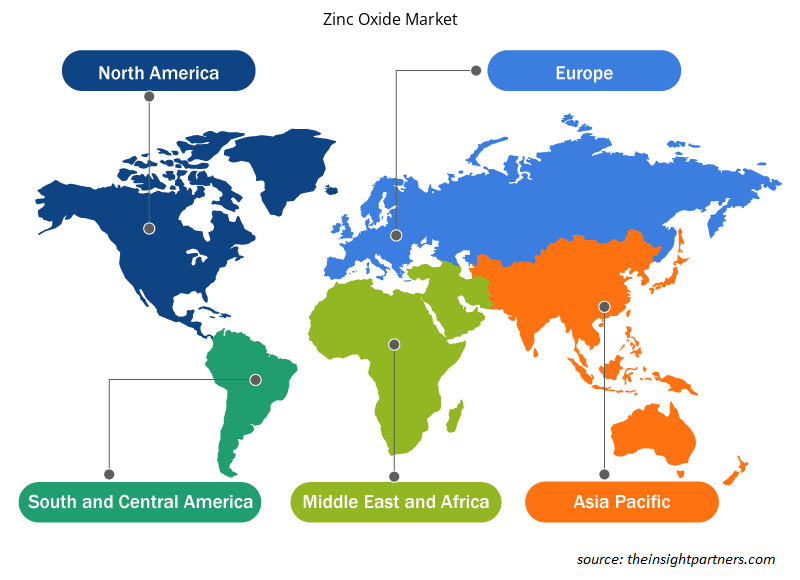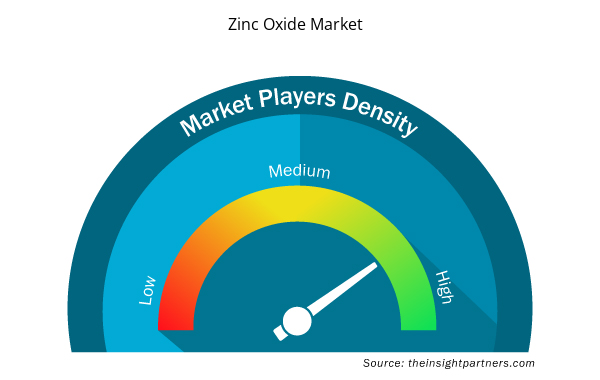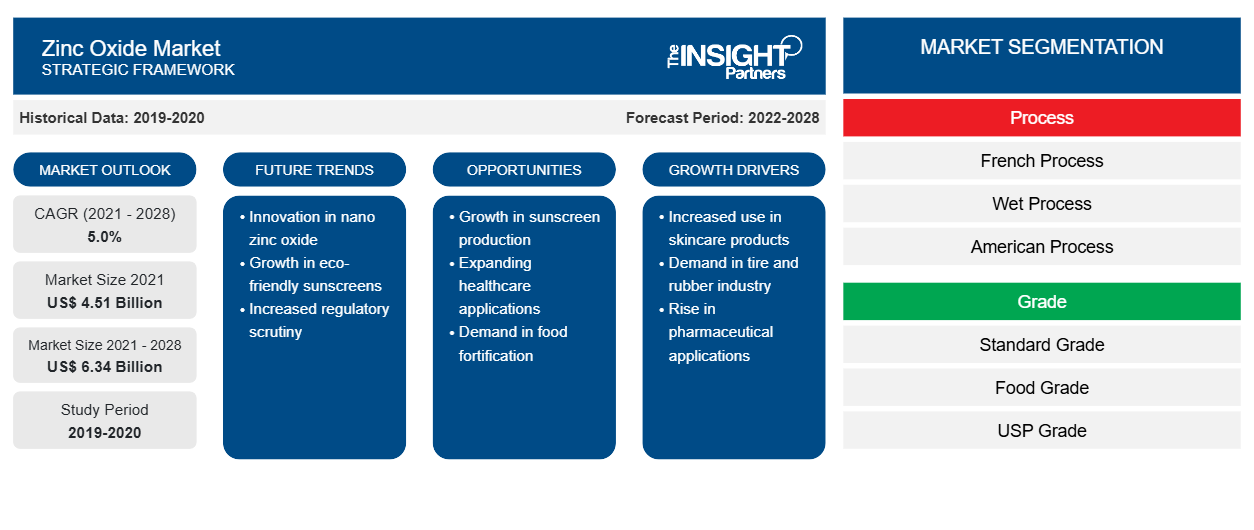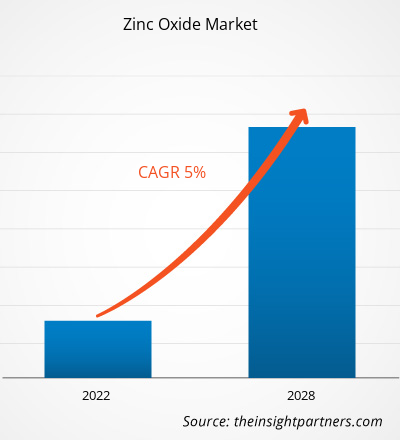El tamaño del mercado de óxido de zinc se valoró en US$ 4.506,51 millones en 2021 y se proyecta que alcance los US$ 6.338,82 millones para 2028; se espera que crezca a una CAGR del 5,0% de 2021 a 2028. CAGR of 5.0% from 2021 to 2028.
El óxido de zinc es un compuesto inorgánico con la fórmula ZnO. Es un polvo blanco insoluble en agua y se utiliza ampliamente como aditivo en numerosos materiales y productos. Además, el ZnO se utiliza para la vulcanización del caucho para aumentar su durabilidad. La industria de los neumáticos también utiliza este caucho vulcanizado para la fabricación de neumáticos. La industria del caucho consumió más de la mitad del ZnO producido en todo el mundo debido a la creciente producción de neumáticos. Además, el aumento de la producción de dispositivos inteligentes y la utilización de óxido de zinc en productos cosméticos y productos de cuidado personal, incluidos el maquillaje, las lociones para bebés, los polvos y los jabones de baño, son los impulsores clave del mercado del óxido de zinc . También se utiliza como agente de carga, colorante y protector de la piel en productos farmacéuticos de venta libre, como el protector solar.
Además, el óxido de zinc se utiliza ampliamente como aditivo para aceites lubricantes de motores de automóviles para reducir la corrosión por oxidación y el desgaste. Los óxidos de zinc se utilizan para fabricar varios tipos de lubricantes, como lubricantes de extrema presión, lubricantes resistentes a las convulsiones y grasas. Por lo tanto, los productos mencionados anteriormente tienen una gran demanda y las respectivas industrias están creciendo positivamente. Por ejemplo, en 2021, la industria cosmética obtuvo alrededor de 81 mil millones de dólares en ingresos en todo el mundo y registró un crecimiento de alrededor del 8% en comparación con el año anterior, según el estudio de Statista. De manera similar, en 2021, los lubricantes para automóviles registraron 70,2 mil millones de ingresos, un aumento de alrededor del 5% en comparación con 2020, según el informe de Statista. Por lo tanto, la amplia gama de aplicaciones del óxido de zinc está aumentando su tasa de consumo y, posteriormente, impulsando el crecimiento del mercado.
Personalice este informe según sus necesidades
Obtendrá personalización en cualquier informe, sin cargo, incluidas partes de este informe o análisis a nivel de país, paquete de datos de Excel, así como también grandes ofertas y descuentos para empresas emergentes y universidades.
- Obtenga las principales tendencias clave del mercado de este informe.Esta muestra GRATUITA incluirá análisis de datos, desde tendencias del mercado hasta estimaciones y pronósticos.
Impacto de la pandemia de COVID-19 en el mercado del óxido de zinc
La pandemia de COVID-19 provocó importantes perturbaciones en el crecimiento de diversas industrias a nivel mundial. De manera similar, la pandemia de COVID-19 tuvo un gran impacto en el mercado de óxido de zinc en 2020, cuando la cadena de suministro de la materia prima de óxido de zinc se vio obstaculizada debido a la restricción del transporte de mercancías. Las normas de confinamiento flexibilizadas en varios países y la creciente industria farmacéutica sostuvieron la demanda mundial de óxido de zinc. Además de esto, el rápido programa de vacunación contra la COVID-19 y el aumento de la adopción de óxido de zinc para productos medicinales a nivel mundial están impulsando el crecimiento del mercado de óxido de zinc, y los fabricantes de óxido de zinc están experimentando un crecimiento significativo en su negocio.lockdown norms in several countries and the growing pharmaceutical industry sustained global demand for zinc oxide. In addition to this, the rapid COVID-19 vaccinations program and rise in adoption of zinc oxide for medicinal products globally are flourishing the growth of the zinc oxide market, and manufacturers of zinc oxide are witnessing significant growth in their business.
Perspectivas de mercado:
creciente demanda de nanopartículas de óxido de zinc verde en la agriculturaNanoparticles in Agriculture
Con la creciente demanda de alimentos libres de químicos a nivel mundial, el consumo de nanopartículas de óxido de zinc verde está aumentando, ya que es una alternativa segura a los métodos químicos convencionales sin dejar ningún contaminante del aire. Las nanopartículas de óxido de zinc son efectivas para la germinación y mejoran el desarrollo de las plantas. También ayudan a aumentar la tasa de crecimiento del tallo y las raíces sin extraer nutrientes del suelo. La demanda de nanopartículas de óxido de zinc verde aumenta gradualmente debido a sus propiedades revitalizantes del suelo y al aumento del rendimiento de los cultivos.nanoparticle consumption is increasing since it is a safe alternative to conventional chemical methods without leaving any air pollutants. Zinc oxide nanoparticles are effective for germination and improve the development of plants. It also helps boost the growth rate of stem and roots without extracting soil nutrients. The demand for green zinc oxide nanoparticles gradually increases due to their soil reviving properties and increased crop yield.
Perspectivas de proceso
Según el proceso, el mercado mundial de óxido de zinc se segmenta en proceso francés, proceso húmedo, proceso americano y otros. El segmento de proceso francés lideró el mercado mundial de óxido de zinc en 2020. El proceso francés también se conoce como proceso indirecto; en este proceso, el zinc se funde en un horno y se vaporiza a 910 grados. La reacción inmediata del vapor de zinc con el oxígeno del aire produce óxido de zinc.american process, and others. The french process segment led the global zinc oxide market in 2020. The french process is also known as the indirect process; in this process, zinc is melted in a furnace and vaporized at 910 degrees. The immediate reaction of the zinc vapor with oxygen from the air produces zinc oxide.
Información sobre calificaciones
Según el grado, el mercado de óxido de zinc se segmenta en grado estándar, grado alimenticio, grado USP y otros. El segmento de grado estándar lideró el mercado mundial de óxido de zinc en 2020. El óxido de zinc de grado estándar se usa ampliamente en laboratorios, investigación y desarrollo como estándar de referencia durante la experimentación. El óxido de zinc de grado estándar es óxido de zinc puro y de alta calidad.
Perspectivas regionales del mercado de óxido de zinc
Los analistas de Insight Partners explicaron en detalle las tendencias y los factores regionales que influyen en el mercado de óxido de zinc durante el período de pronóstico. Esta sección también analiza los segmentos y la geografía del mercado de óxido de zinc en América del Norte, Europa, Asia Pacífico, Oriente Medio y África, y América del Sur y Central.

- Obtenga datos regionales específicos para el mercado de óxido de zinc
Alcance del informe de mercado de óxido de zinc
| Atributo del informe | Detalles |
|---|---|
| Tamaño del mercado en 2021 | 4.510 millones de dólares estadounidenses |
| Tamaño del mercado en 2028 | 6.340 millones de dólares estadounidenses |
| CAGR global (2021-2028) | 5.0% |
| Datos históricos | 2019-2020 |
| Período de pronóstico | 2022-2028 |
| Segmentos cubiertos | Por proceso
|
| Regiones y países cubiertos | América del norte
|
| Líderes del mercado y perfiles de empresas clave |
|
Densidad de actores del mercado de óxido de zinc: comprensión de su impacto en la dinámica empresarial
El mercado de óxido de zinc está creciendo rápidamente, impulsado por la creciente demanda de los usuarios finales debido a factores como la evolución de las preferencias de los consumidores, los avances tecnológicos y una mayor conciencia de los beneficios del producto. A medida que aumenta la demanda, las empresas amplían sus ofertas, innovan para satisfacer las necesidades de los consumidores y aprovechan las tendencias emergentes, lo que impulsa aún más el crecimiento del mercado.
La densidad de actores del mercado se refiere a la distribución de las empresas o firmas que operan dentro de un mercado o industria en particular. Indica cuántos competidores (actores del mercado) están presentes en un espacio de mercado determinado en relación con su tamaño o valor total de mercado.
Las principales empresas que operan en el mercado de óxido de zinc son:
- Zinc permanente
- L. Brügge
Descargo de responsabilidad : Las empresas enumeradas anteriormente no están clasificadas en ningún orden particular.

- Obtenga una descripción general de los principales actores clave del mercado de óxido de zinc
Información sobre aplicaciones
Según la aplicación, el mercado mundial de óxido de zinc se segmenta en caucho, agricultura, productos químicos y lubricantes, vidrio y cerámica, pintura y pigmentos, productos farmacéuticos y otros. El segmento de caucho lideró el mercado mundial de óxido de zinc en 2020. El caucho se utiliza ampliamente en la fabricación de diversos productos, como neumáticos y cámaras de desecho; el uso creciente de caucho aumenta la demanda del mercado de óxido de zinc. El óxido de zinc se utiliza en la industria del caucho para prevenir la decoloración y mantener la estabilidad térmica y la transparencia del producto.
EverZinc; L. Brüggemann GmbH & Co.; US Zinc; Zochem, Inc.; Umicore; Grillo-Werke AG; Rubamin; JG Chemicals Pvt. Ltd.; Pan-Continental Chemical Co., Ltd.; y Akrochem Corporation son algunos de los actores que se centran activamente en el desarrollo de óxido de zinc más innovador para diversas aplicaciones.
Informe Destacado
- Tendencias progresivas del mercado de óxido de zinc para ayudar a los actores a desarrollar estrategias efectivas a largo plazo
- Estrategias de crecimiento empresarial adoptadas por los mercados desarrollados y en desarrollo
- Análisis cuantitativo del mercado de óxido de zinc de 2019 a 2028
- Estimación de la demanda mundial de óxido de zinc
- Análisis de Porter para ilustrar la eficacia de los compradores y proveedores que operan en la industria del óxido de zinc
- Avances recientes para comprender el escenario competitivo del mercado
- Tendencias y perspectivas del mercado, así como factores que impulsan y restringen el crecimiento del mercado de óxido de zinc
- Asistencia en el proceso de toma de decisiones destacando las estrategias de mercado que sustentan el interés comercial, lo que conduce al crecimiento del mercado.
- El tamaño del mercado de óxido de zinc en varios nodos
- Descripción detallada y segmentación del mercado, así como la dinámica de la industria del óxido de zinc.
- Tamaño del mercado de óxido de zinc en varias regiones con oportunidades de crecimiento prometedoras
- Análisis histórico (2 años), año base, pronóstico (7 años) con CAGR
- Análisis PEST y FODA
- Tamaño del mercado Valor/volumen: global, regional, nacional
- Industria y panorama competitivo
- Conjunto de datos de Excel



Report Coverage
Revenue forecast, Company Analysis, Industry landscape, Growth factors, and Trends

Segment Covered
This text is related
to segments covered.

Regional Scope
North America, Europe, Asia Pacific, Middle East & Africa, South & Central America

Country Scope
This text is related
to country scope.
Preguntas frecuentes
Growing demand for butyric acid from animal feed sector is one of the major driving factors for the market. Butyric acid is known for its beneficial effects on gut health and development. For decades, it has been in use in the animal feed industry for ensuring improved gut health and animal performance. The use of butyric acid in animal nutrition also helps in improving nutrient absorption.
Asia Pacific (APAC) is anticipated to grow with the fastest CAGR at rate of 15.3% from 2021 to 2028. The growing number of livestock farms in APAC is propelling animal feed consumption levels, subsequently leading to the proliferation of the butyric acid market.
Due to the COVID-19 pandemic, butyric acid manufacturers witnessed a slight disruption in the supply chain of butyric acid during the first two quarters of 2020. However, the supply chain of butyric acid materials has been restored, and production activities have regained normalcy in late 2020. Later, the market was not significantly negatively impacted by the pandemic. Further, with the growing COVID-19 vaccinations and eased in lockdown restrictions, the global economy is resuming, and subsequently, the butyric acid market is regaining its growth.
Based on application, the animal feed segment accounted the largest share of the global butyric acid market. Butyric acid and fatty acids are extensively used in production of poultry and swine feed due to its beneficial properties such as improving digestibility, better colonisation resistance, and improved growth performance among young livestock.
The major players operating in the global butyric acid market are Eastman Chemical Company; OQ Chemicals GmbH; Tokyo Chemical Industry Co., Ltd.; Perstorp Holding AB; Alfa Aesar; MERCK KGaA; Vigon International, LLC.; Hefei TNJ Chemical Industry Co.,Ltd.; KUNSHAN ODOWELL CO.,LTD; and Yufeng International Co.,Ltd.
During the forecast period, Asia Pacific is anticipated to account for the largest share in the global butyric acid market. The region houses few of the fastest developing economies of the world such as China and India and that are the major consumer of the butyric acid. Moreover, in the Asia Pacific region, there is a growing number of livestock farms which is increasing the consumption of animal feed and subsequently proliferating the butyric acid market.
Trends and growth analysis reports related to Chemicals and Materials : READ MORE..
The List of Companies - Zinc Oxide Market
- EverZinc
- L. Brüggemann GmbH & Co.
- U.S. Zinc.
- Zochem, Inc.
- Umicore
- Grillo-Werke AG
- Rubamin
- JG Chemicals Pvt. Ltd.
- Pan-Continental Chemical Co., Ltd.
- Akrochem Corporation
The Insight Partners performs research in 4 major stages: Data Collection & Secondary Research, Primary Research, Data Analysis and Data Triangulation & Final Review.
- Data Collection and Secondary Research:
As a market research and consulting firm operating from a decade, we have published and advised several client across the globe. First step for any study will start with an assessment of currently available data and insights from existing reports. Further, historical and current market information is collected from Investor Presentations, Annual Reports, SEC Filings, etc., and other information related to company’s performance and market positioning are gathered from Paid Databases (Factiva, Hoovers, and Reuters) and various other publications available in public domain.
Several associations trade associates, technical forums, institutes, societies and organization are accessed to gain technical as well as market related insights through their publications such as research papers, blogs and press releases related to the studies are referred to get cues about the market. Further, white papers, journals, magazines, and other news articles published in last 3 years are scrutinized and analyzed to understand the current market trends.
- Primary Research:
The primarily interview analysis comprise of data obtained from industry participants interview and answers to survey questions gathered by in-house primary team.
For primary research, interviews are conducted with industry experts/CEOs/Marketing Managers/VPs/Subject Matter Experts from both demand and supply side to get a 360-degree view of the market. The primary team conducts several interviews based on the complexity of the markets to understand the various market trends and dynamics which makes research more credible and precise.
A typical research interview fulfils the following functions:
- Provides first-hand information on the market size, market trends, growth trends, competitive landscape, and outlook
- Validates and strengthens in-house secondary research findings
- Develops the analysis team’s expertise and market understanding
Primary research involves email interactions and telephone interviews for each market, category, segment, and sub-segment across geographies. The participants who typically take part in such a process include, but are not limited to:
- Industry participants: VPs, business development managers, market intelligence managers and national sales managers
- Outside experts: Valuation experts, research analysts and key opinion leaders specializing in the electronics and semiconductor industry.
Below is the breakup of our primary respondents by company, designation, and region:

Once we receive the confirmation from primary research sources or primary respondents, we finalize the base year market estimation and forecast the data as per the macroeconomic and microeconomic factors assessed during data collection.
- Data Analysis:
Once data is validated through both secondary as well as primary respondents, we finalize the market estimations by hypothesis formulation and factor analysis at regional and country level.
- Macro-Economic Factor Analysis:
We analyse macroeconomic indicators such the gross domestic product (GDP), increase in the demand for goods and services across industries, technological advancement, regional economic growth, governmental policies, the influence of COVID-19, PEST analysis, and other aspects. This analysis aids in setting benchmarks for various nations/regions and approximating market splits. Additionally, the general trend of the aforementioned components aid in determining the market's development possibilities.
- Country Level Data:
Various factors that are especially aligned to the country are taken into account to determine the market size for a certain area and country, including the presence of vendors, such as headquarters and offices, the country's GDP, demand patterns, and industry growth. To comprehend the market dynamics for the nation, a number of growth variables, inhibitors, application areas, and current market trends are researched. The aforementioned elements aid in determining the country's overall market's growth potential.
- Company Profile:
The “Table of Contents” is formulated by listing and analyzing more than 25 - 30 companies operating in the market ecosystem across geographies. However, we profile only 10 companies as a standard practice in our syndicate reports. These 10 companies comprise leading, emerging, and regional players. Nonetheless, our analysis is not restricted to the 10 listed companies, we also analyze other companies present in the market to develop a holistic view and understand the prevailing trends. The “Company Profiles” section in the report covers key facts, business description, products & services, financial information, SWOT analysis, and key developments. The financial information presented is extracted from the annual reports and official documents of the publicly listed companies. Upon collecting the information for the sections of respective companies, we verify them via various primary sources and then compile the data in respective company profiles. The company level information helps us in deriving the base number as well as in forecasting the market size.
- Developing Base Number:
Aggregation of sales statistics (2020-2022) and macro-economic factor, and other secondary and primary research insights are utilized to arrive at base number and related market shares for 2022. The data gaps are identified in this step and relevant market data is analyzed, collected from paid primary interviews or databases. On finalizing the base year market size, forecasts are developed on the basis of macro-economic, industry and market growth factors and company level analysis.
- Data Triangulation and Final Review:
The market findings and base year market size calculations are validated from supply as well as demand side. Demand side validations are based on macro-economic factor analysis and benchmarks for respective regions and countries. In case of supply side validations, revenues of major companies are estimated (in case not available) based on industry benchmark, approximate number of employees, product portfolio, and primary interviews revenues are gathered. Further revenue from target product/service segment is assessed to avoid overshooting of market statistics. In case of heavy deviations between supply and demand side values, all thes steps are repeated to achieve synchronization.
We follow an iterative model, wherein we share our research findings with Subject Matter Experts (SME’s) and Key Opinion Leaders (KOLs) until consensus view of the market is not formulated – this model negates any drastic deviation in the opinions of experts. Only validated and universally acceptable research findings are quoted in our reports.
We have important check points that we use to validate our research findings – which we call – data triangulation, where we validate the information, we generate from secondary sources with primary interviews and then we re-validate with our internal data bases and Subject matter experts. This comprehensive model enables us to deliver high quality, reliable data in shortest possible time.


 Obtenga una muestra gratuita de este informe
Obtenga una muestra gratuita de este informe